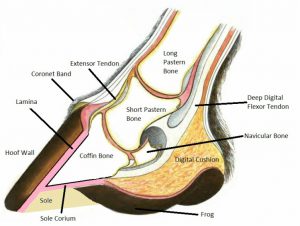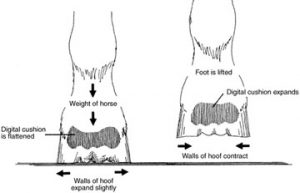 If you’ve been in the horse industry for any length of time then you have heard the saying “no hoof, no horse”. It is one of the non-opinion based comments that exist in the horse world. Some of the late greats such as Secretariat met their maker due to chronic hoof disease. It reminds me of something my mom always told me growing up, “be sure to take care of your teeth and your feet and they will take care of you”. While equine dentistry is another topic, we will focus on why the maintenance and care of your horse’s feet are important.
If you’ve been in the horse industry for any length of time then you have heard the saying “no hoof, no horse”. It is one of the non-opinion based comments that exist in the horse world. Some of the late greats such as Secretariat met their maker due to chronic hoof disease. It reminds me of something my mom always told me growing up, “be sure to take care of your teeth and your feet and they will take care of you”. While equine dentistry is another topic, we will focus on why the maintenance and care of your horse’s feet are important.
When I am looking at a horse randomly or for potential purchase the feet are the very first thing I direct my attention to. If they don’t check out, then I am quickly moving on to the next prospect. What is a hoof responsible for? Bearing weight, resisting wear, absorbing shock, and assisting in blood flow are just a few of its functions. Each of the four hooves are the support mechanism for the limb above it. When you consider the sheer size of a horse in comparison to their hooves, this is impressive. A horse’s hoof must be able to distribute the weight of the forces above it while being functional and allowing the horse to move about without fatigue.
Factors in Hoof Health
 There are many structures that make up the foot. They are work in concert with one another to transport the horse. When one begins to fail you often see a domino effect and the resulting lameness of your horse. Additionally, many factors play a part in overall hoof health. Genetics is one of the biggest and something you should pay great attention to. This is a “non-negotiable” factor and one that you take as it is dealt to you. There are many genetic lines of horses that are known for certain features. Stick to the features that do not effect structural soundness. Two other factors in hoof health are somewhat controllable; those are environment and nutrition.
There are many structures that make up the foot. They are work in concert with one another to transport the horse. When one begins to fail you often see a domino effect and the resulting lameness of your horse. Additionally, many factors play a part in overall hoof health. Genetics is one of the biggest and something you should pay great attention to. This is a “non-negotiable” factor and one that you take as it is dealt to you. There are many genetic lines of horses that are known for certain features. Stick to the features that do not effect structural soundness. Two other factors in hoof health are somewhat controllable; those are environment and nutrition.
The environment can bring about dry or wet conditions. Each cause a response in the hoof, and too much of either one is not ideal. Moisture is necessary to maintain hoof quality. Hooves are constantly losing water so water in brought in systemically from blood and lymph supplies of structures in the hoof, or environmentally from the ground. If extreme wet conditions persist, try to find a dry stall or paddock for your horse to spend partial time in, or consider shoes if the conditions are unchangeable. I have found it easier to combat dry hooves than the aforementioned soggy hooves. There are many products on the market to moisten the hoof.
Nutrition is a major driver of overall horse health, but hoof health and hoof size is directly correlated to nutrition. Horses fed an optimal diet have an 80% increase in hoof-sole-border area size compared to horses fed a limited diet. Each part of the hoof contains various mineral concentrations that together determine the overall strength of that hoof. Horses with white hooves have poor feet, right? Wrong. There is no evidence to support this industry theory. Hoof color is merely influenced by the pigmentation above the hoof.
Hoof Care
 Young horses have a greater rate of hoof growth than older horses. Hoof growth rate has been correlated with heart rate. Foals have a heart rate almost twice as fast as an adult horse and therefore a significantly increased hoof growth. For a mature horse the average hoof growth per month is three-eighths inch. Hoof balancing, which is what happens when a farrier trims a horse’s hooves, is recommended every 4-6 weeks depending on the rate of growth.
Young horses have a greater rate of hoof growth than older horses. Hoof growth rate has been correlated with heart rate. Foals have a heart rate almost twice as fast as an adult horse and therefore a significantly increased hoof growth. For a mature horse the average hoof growth per month is three-eighths inch. Hoof balancing, which is what happens when a farrier trims a horse’s hooves, is recommended every 4-6 weeks depending on the rate of growth.
Does your horse need shoes? That is an open-ended question and the simple answer is, maybe. Shoes serve a definite purpose in many cases, but a lot of horses do just as well with a balanced barefoot trim on a regular schedule. Shoes play a part in combating those genetics we discussed earlier or those extenuating environmental conditions and definitely in many performance horse realms that are asking for advanced movements on sometimes unfavorable surfaces for the horse. My best advice is to first understand what hoof care your horse requires and do your homework to find a farrier who can deliver the necessary care, and take absolutely no prisoners on the quest for an adequate farrier, after all they are behind the wheel so to speak.
If you are new to horse ownership be sure to ask and ask again when you are unsure of hoof related matters. There are many old wives tales about hoof health, and some will cost you unnecessary money while others are sure to cost you time and patience. Build your network of industry professionals that understand the science of hoof anatomy and the intended use of your horse. This is NOT a one size fits all situation. Stay tuned for more articles on hoof anatomy, common diseases, and corrections of hoof issues.
 1
1
